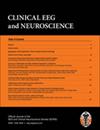Special Issue: Update on Neural Oscillations in Neuropsychiatric Disorders.
IF 1.7
4区 医学
Q3 CLINICAL NEUROLOGY
引用次数: 0
Abstract
The present issue highlights recent progress in the analysis of oscillatory activity for the assessment, understanding and remediation of psychiatric and neurologic disorders. Contemporary interest in neural synchrony and oscillations in neuropsychiatric disorders has been motivated by investigations of cellular and network oscillations, modeling of neural networks and advances in signal analysis. Hebb proposed that synchronous activation between two neurons strengthened connectivity between them; and that a reverberatory neural circuit could maintain a representation of a stimulus in memory. More recent findings implicate neural synchrony and oscillations in feature binding, attentional selection, arousal, memory operations and consciousness. Consequently, disturbances of oscillations within and between neural ensembles may contribute to sensory, behavioral and cognitive deficits in neuropsychiatric disorders. Because human EEG and MEG activity are generated by synchronized inhibitory and excitatory postsynaptic potentials within large ensembles of neurons, they are well suited for the detection of neural synchrony and oscillations with millisecond temporal resolution. In the present issue, investigators describe alterations of spontaneous or evoked oscillatory activity in a wide range of conditions, including Parkinson’s disease (Bayraktaroglu et al, 2023), Alzheimer’s disease (Fide et al, 2023), neurodegenerative disorders (Keller et al, 2023) depression (Riddle et al, 2023), schizophrenia (Basar Eroglu et al, 2023; Lundin et al, 2023; Peterson et al, 2023; Roach et al, 2023) and cannabis use disorders (Syed et al, 2023). These studies are broadly consistent with the hypothesis that disorders that affect signaling or connectivity among neurons will be associated with aberrant oscillatory activity. Moreover, these data indicate the potential of oscillatory measures for probing neuropathological mechanisms, identifying biomarkers, tracking course and predicting outcomes. Advances in signal analysis have been critical for the characterization of oscillatory activity in neuropsychiatric populations. At a single channel, time frequency analysis yields measures of frequency, amplitude and phase. Time-frequency analysis allows the assessment of the temporal dynamics of event-related oscillations before and after an event of interest (Delorme and Makeig, 2004; Keil et al, 2022). The papers in this issue draw on a rich array of methods, including resting power spectrum, event-related phase locking, phase delay, event-related power spectrum, coherence, and resting or event-related cross-frequency coupling. Lundin et al (2023) investigated the event-related power spectrum in patients with schizophrenia and Fide et al (2023) examined patients with Alzheimer’s disease patients. Event-related phase locking, also termed inter-trial coherence, is a measure of phase consistency across trials relative to a time locking event for a specific frequency band. In the present issue, Roach et al (2022), Basar Eroglu et al (2023), Lundin et al (2023), Roach et al (2023), and Syed et al (2023) used phase-locking analysis to assess event-related responses in neuropsychiatric disorders. Roach et al (2023) also employ a novel measure of phase locking angle to the auditory steady state response (ASSR) in persons with schizophrenia. Coherence is a measure of connectivity of the EEG/MEG signal between two different sensor sites computed from spectral power or phase consistency (Lachaux et al, 1999). In the present issue, Fide et al (2023) used coherence methodology to analyze the effect of acetylcholinesterase inhibitors in Alzheimer’s Disease patients. Keller et al (2023) reviewed coherence and other measures of EEG signals to characterize cognitive decline in neurodegenerative disorders. Cross-frequency coupling measures the relationship between different frequency bands and may support coordination of activity within local neural circuits to other regions in the brain. In the present issue, Bayraktaroğlu et al (2023) analyzed phase-amplitude cross-frequency coupling in healthy controls and Parkinson’s disease patients with mild cognitive impairment and dementia Riddle and Frolich (2023) discuss phase-amplitude cross-frequency coupling as a biomarker in depression. In aggregate, these studies also identify key areas for future research utilizing EEG/MEG to understand the role of neural oscillations in neurobehavioral disorders. Advances in clinical applicationswill require establishing adequate sensitivity and specificity to contribute to diagnostic and prognostic decisions, as well as functional assessment. Large, multisite samples will be necessary to capture multifactorial relationships with adequate statistical power. In terms of understanding illness pathophysiology, Riddle and Frolich (2023) emphasize the importance of utilizing research strategies that examine the relationships between symptom severity, mental activity and the neural activity signature. Manipulations targeting the neural activity, such as non-invasive neurostimulation, can then test causal relationships among these factors. This integrative approach provides a conceptual framework for experimental design and modeling, rather than relying on interpretation of correlations among heterogeneous clinical and Editorial特刊:神经精神疾病中神经振荡的最新进展。
本文章由计算机程序翻译,如有差异,请以英文原文为准。
求助全文
约1分钟内获得全文
求助全文
来源期刊

Clinical EEG and Neuroscience
医学-临床神经学
CiteScore
5.20
自引率
5.00%
发文量
66
审稿时长
>12 weeks
期刊介绍:
Clinical EEG and Neuroscience conveys clinically relevant research and development in electroencephalography and neuroscience. Original articles on any aspect of clinical neurophysiology or related work in allied fields are invited for publication.
 求助内容:
求助内容: 应助结果提醒方式:
应助结果提醒方式:


